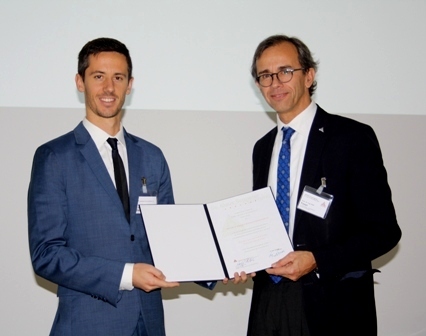Dr. Klaus Seppeler Stiftungspreis
für Herrn Dr. Matteo Stefanoni

Hr. Prof. Feser mit Hrn. Dr. Stefanoni bei der Preisverleihung
Zum fünfzehnten Mal wurde auf der Mitgliederversammlung am 12. November 2019 der Stiftungspreis an Dr. Matteo Stefanoni für seine Arbeit zum Thema 'The corrosion of steel in near-neutral porous media – Corrosion rate in carbonated concrete' verliehen.
This thesis elucidates the mechanism of steel corrosion in carbonated concrete – as a model system for dense porous media – by using a novel experimental setup and by interpreting the results on the basis of a combination of the theory of capillary condensation and rigorous electrochemistry.
Reinforced concrete is the most used man-made material worldwide. One of the main degradation processes of reinforced concrete structures comes from its carbonation, the reaction with environmental CO2. When carbon dioxide enters the pore structure, it dissolves in the pore solution and neutralize the initially high alkalinity (pH >13), this high pH is the reason why steel in concrete is protected from corrosion. Thus, passivity is lost and corrosion starts. Carbonation-induced corrosion damages account for billions in maintenance and repair every year. Since 1980, the mechanism of corrosion in carbonated concrete has been debated.
In this thesis the corrosion of steel in carbonated mortars was studied by means of a new experimental set up. The new test setup consists of small (8 x 8 cm2) and thin (0.6 cm) mortar samples instrumented with a reference electrode, 5 steel wire electrodes and a stainless steel counter electrode. Parameters that can be measured are electrical resistivity, corrosion potential and corrosion rate, oxygen diffusion and consumption. It was shown that the traditionally proposed mechanisms controlling the corrosion rate, such as resistive control and cathodic control, are incorrect. Merging electrochemistry and water capillary condensation theory allowed to explain the mechanism of pseudo-uniform corrosion of carbon steel embedded in a dense porous system. The saturation degree of the pore structure defines the “electrochemically active area” of the steel surface, which is accountable for the orders of magnitude of corrosion rate variation depending on the exposure condition. On the other hand, the available volume for corrosion products diffusion influences the electrochemistry of the system, mainly by modifying the anodic reversible potential, and consequently the corrosion rate. In conclusion, the corrosion mechanism of carbon steel in carbonated concrete could be determined and the corrosion rate uniformly expressed – for every different humidity state, water to binder ratio and binder type – as a function of water content and porosity.